December, 2018 TIPS TO REMEMBER - Gravy
It's that time of year again. Gravy time. If you're cooking for family, friends, or just yourself for the holidays, you might want to do a roast of some kind. Most likely, you're going to want gravy with your roast, even if it's vegan - and if experience serves me well, you're going to need at least twice the amount of gravy you think you do - and it's okay, you can freeze the extra.

Aside from being a sauce made from meat drippings, gravy can be made with any kind of broth, vegetables, or extracts. In some European and Commonwealth cuisine, gravy is solely the sauce derived from meat juices, boullion, etc., and does not include thickened sauces. For the sake of culinary arts, we will refer to thickened sauces in general as gravy and with the exception of "Red-Eye Gravy," use the word 'jus,' as in "au jus" for meat juices served as a sauce without thickener.
"GRAVY" is derived from the French word "gravé," found in medieval French cookbooks. One of the oldest recorded recipes for gravy comes from 'The Forme of Cury,' a 14th century cookbook.
| Roux = | 1 Part Butter, Fat or Oil
1 Part FlourWhisk together over medium to medium-high heat until well combined and flour is no longer raw |
|---|
| Cornstarch Paste = | 1 Part Warm Water
2 Parts Corn StarchWhisk together in a small bowl to dissolve cornstarch and remove lumps |
|---|
Here's a rundown of the different types of gravies I've made with very basic instruction. You may want to skim the fat off of your pan drippings and either use the meat fats to make your roux, or use a vegan alternative.
GRAVY VARIETIES:

Brown:
- Cook drippings from roasted meat or poultry on high with desired herbs
- Thicken with flour or cornstarch paste

Cream, Country, Milk, Sausage, Sawmill, or White:
- Make a roux from flour and meat fats, such as sausage or bacon
- Add milk or cream, stirring constantly until thickened
- Season with salt, black pepper and herbs
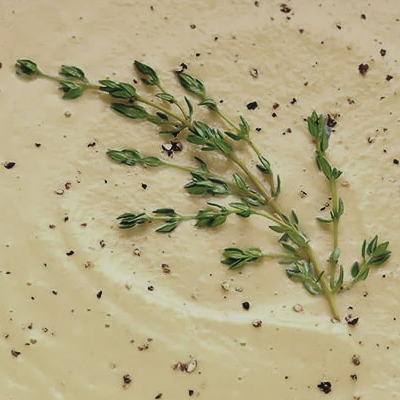
Egg:
- Make a thick roux from meat drippings (traditionally bacon) and flour
- Add water, broth, or milk and season to taste
- Bring the liquid back up to a boil and slowly pour in one well-beaten egg, whisking constantly

Giblet:
- Boil or slow-cook giblets and vegetables with herbs until everything is tender
- Strain and purée edible vegetable pieces with liquid, return to stove
- Finely mince giblets and add back to pot, reduce and thicken with flour or corn starch paste as necessary

Mushroom:
- Pan-fry fresh mushrooms and deglaze or slow-cook dried mushrooms with herbs and wine or stock
- Strain and purée mushrooms into thin paste, reserving some for a chunky consistency if desired
- Add back to liquid and bring to a boil, season to taste and thicken with a roux or mushroom powder

Onion:
- Slow-cook or 'sweat' onions with stock or wine for 1-3 hours
- Strain and purée onion, reserving some for a chunky consistency if desired
- Season to taste and reduce as necessary, do not use thickener

Red:
- Slow-cook tomato sauce with desired meat drippings and vegetables for 2-3 hours
- Season to taste (this may also be a curry) and reduce by at least half
- Purée until smooth with olive oil or butter to desired glossiness
 Red-Eye:
- Fry ham steaks with butter in a skillet or frying pan
- Deglaze pan with black coffee and do not use thickener

Vegetable or Vegetarian:
- Boil, roast or slow-cook vegetables until they are tender and the desired juices are collected
- Strain if necessary and purée edible portions of softened vegetables with liquid, reserving smaller chunks for desired consistency
- Bring vegetable juices to a boil and reduce if necessary, season to taste - wine or yeast extracts are sometimes added, like Marmite or Vegemite
- Thicken with a roux or corn starch paste - vegan butter, margarine or oil is suggested
Gravy doesn't have to be a time consuming process. You can make gravy in uder five minutes with little more than water, butter, flour and a few boullion cubes. For some added nutrition and flavor, try this recipe out:
FC EMERGENCY GRAVY:
| Turkey Stock | : | 2 cups |
|---|
| Mixed Vegetables | : | 1 cup, canned or frozen |
|---|
| Butter | : | ¼ cup |
|---|
| Choice Herbs | : | ½tsp to taste, optional |
|---|
| Salt | : | ¼tsp, to taste |
|---|
| Cornstarch or Roux | : | as needed, optional |
|---|

DIRECTIONS:
Saucepan- add all ingredients except cornstarch or roux and bring to a boil
Simmer- for 3-5 minutes or more, stirring occasionally until vegetables are softened.
Strainer or Colander- strain vegetables and purée with ½ cup of broth until smooth.
Saucepan- whisk purée and remaining broth together, return to stove and bring back up to a boil.
Reduce Liquid- and thicken with cornstarch or roux to desired consistency, stirring frequently.
I used this recipe on Thanksgiving when the turkey gravy ran out. If you don't have turkey stock, use half chicken and half beef or whatever stock you prefer. For the best results use mixed vegetables that have corn, peas, carrots and green beans; although just canned green beans will work.
November, 2018 Avocado + Guacamole
 Persea Americana: From the Lauraceae family, part of the Laurales (laurel) order. A large and buttery fruit from a medium-sized evergreen tree, the avocado tree was first domesticated more than 5,000 years ago in Mesoamerica and is thought to have originated from the highlands of south-central Mexico and Guatemala. Botanically avocados are large berries containing a single seed. The domesticated fruit is either pear-shaped, egg-shaped, or spherical with a leathery green, brown, purplish, or black skin, and has a smooth, golden-green flesh when ripe. Avocados are dense in nutrients and high in fat content, often eaten to enrich vegetarian diets. Click here for more information about the varieties of California avocados.
"AVOCADO" comes from a modern English rendering of 'avogato' from the Spanish word 'aguacate,' from the Nahuatl (Mexican) word 'āhuacatl,' which derives from the proto-Aztecan '*pa:wa' and may have been used as a euphemism for 'testicle' in Nahuatl vernacular. The earliest known written use of the term stems from 1697 as "avogato pear," and sometimes referred to as "alligator pear" or "butter fruit."
Avocados have recently been adopted as a healthy substitute for butter on toast. No longer just a topping for tacos, the prized produce is a favorite for salads, sandwiches and wraps - and can be found in recipes for everything from smoothies and ice cream to brownies and bread.
"GUACAMOLE" comes from the Nahuatl word 'āhuacamōlli,' meaning "avocado sauce" from 'āhuacatl' or 'avocado' and 'mōlli' or 'sauce.' Informally shortened to 'guac,' the avacodo-based dip was first developed in Mexico and has become a popular part of international cuisine, traditionally served with tortilla chips.
If you're pressed for time and just gotta have some guac, mix cubed avocado with lime juice and your salsa of choice, garnish with minced cilantro if you have it, grab your chips and call it a day. Otherwise, try this recipe out. I recommend serving it with blue corn tortilla chips or homemade empanadas.
FC GUACAMOLE:
| Avocado | : | 2-3 pitted + cubed |
|---|
| Roma Tomato | : | 1 large diced |
|---|
| Lime Juice | : | 2-3 tbsp, divided |
|---|
| Onion | : | 2-3 tbsp minced, optional |
|---|
| Cilantro | : | 1-2 tbsp minced, optional |
|---|
| Jalapeño | : | 1-1½ tbsp seeded + minced |
|---|
| Garlic | : | 1 tbsp minced |
|---|
| Cumin | : | ½ tsp |
|---|
| Coarse Salt | : | ¼-½ tsp, to taste |
|---|
| Cayenne | : | 1 pinch, to taste |
|---|
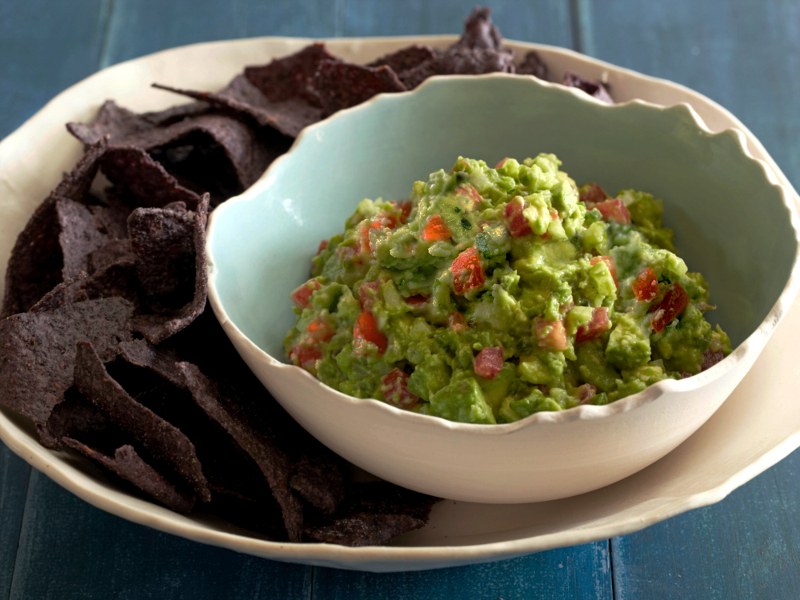
DIRECTIONS:
Small Bowl- mince onion first, if using. Place onion with 1 tbsp lime juice and set aside.
Medium Bowl- dice tomato and mince jalapeno and garlic, toss with cumin and cayenne.
Large Bowl- scoop out the avocado pulp, cube and toss with remaining lime juice to coat.
Mash- ¼-⅓ of your avocado with coarse salt to taste, add back to large bowl.
Add- onion with lime juice and tomato mixture to large bowl with avocado.
Mince- cilantro, if using, and gently fold all ingredients to desired consistency.
NOTE: If you need to store your guacamole, place the pits in with the guacamole and splash the top with more lime juice, cover completely with plastic wrap and seal in a tightly-lidded container. If you prefer your guacamole spicy, go ahead and add hot sauce.
October, 2018 CORIANDER + CILANTRO

Coriandrum Sativum: From the Apiaceae family, part of the Apiales (umbellifer) order.
A vibrantly colored, flat leaf herb with a fragrant, citrusy flavor that is essential to many world cuisines - Mexican, Middle Eastern, Indian, and Asian - in foods like chutney, salad, salsa, and guacamole. The leaves of the plant, commonly mistaken for parsley, spoil quickly when detached from the stalk and greatly diminish in flavor when heated; thus they are often used as garnish or added to the dish in raw form. The stems are typically discarded, unless making into a paste or boiling in a stock; and coriander roots are used in some Asian cuisines like Thai soups and curry pastes, with a deeper, more intense flavor than the leaves.
Dried coriander fruits, or coriander seeds are used as a spice, most notably in pickling vegetables, making sausages, as a part of garam masala, as a gin flavorant, or for brewing beer - such as Belgian Orange Wheat. Coriander seeds are also sometimes used in rye bread, in addition to or as a substitute for caraway. On an interesting side-note, coriander is listed in Coca-Cola's secret formula, most likely cotributing to its complex citrus notes; and coriander essential oil is shown to inhibit certain bacteria, containing mixed polyphenols and terpenes accounting for the pungent aroma and flavor.
"CORIANDER", from the Old French 'coriandre,' which is from the Latin 'coriandrum,' and from the Ancient Greek 'koríannon' or 'koríandron,' is possibly related to 'kóris' or bed bug based on its foetid smell. The earliest form of coriander is 'koriadnon' from Mycenaean Greek, later evolving into 'koriannon' or 'koriandron,' and the German 'koriander.'
"CILANTRO" is the Spanish word for coriander, used as a culinary reference to just the leaves of the plant based on their extensive use in Mexican cuisine.
Cilantro should be used judiciously in cooking. Many people perceive the taste of cilantro as displeasing - some people enjoy it as vivid and refreshing, while others consider it to be too bitter or 'soapy' with a strong aversion to it. Coriander seed is more widely accepted as a food additive with a very different taste and aroma from the leaf. Cilantro and coriander cannot be interchanged - the best substitute for cilantro is culantro or parsley and arugula; and for coriander you can use cumin, garam masala, caraway, or curry powder amd white pepper.
Coriander Seeds:

- Warm, nutty spice with a slightly orange flavor when crushed
- Higher in minerals such as manganese, iron, magnesium, and calcium
- Heating heightens the flavor and pungency
Cilantro Leaves:

- Bright, fragrant and peppery with fresh citrus overtones
- Higher in vitamins A, K, and E
- Loses flavor when heated, dried or frozen
NOTE: Your cilantro will last longer in the refrigerator if you place the stems in a glass of water. You may also want to cover the leaves with a plastic bag, or alternately, place a slightly damp paper towel with the with the cilantro in the grocery vegetable bag and inside your crisper drawer. It's also recommended that you do not wash cilantro until you want to use it. Although it will lose some flavor, you can freeze cilantro. First blanch it in some boiling water, pat dry and spread out thinly in freezer-safe bags. Ground coriander loses its flavor rather quickly, so it is best kept whole and fresh ground.
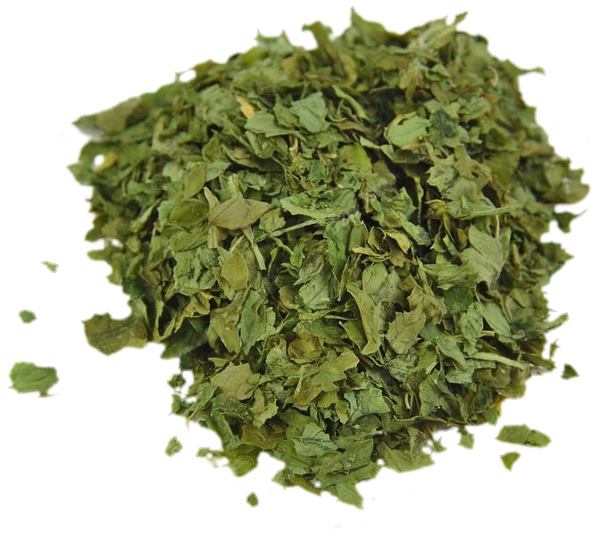
DRIED CILANTRO:
With an oven or dehydrator it's a very easy process to make dried cilantro at home. Simply wash cilantro and pat dry, removing the leaves from the stems. Lay cilantro out on a parchment-covered baking sheet and bake on the upper rack of a 250° pre-heated oven for about 30 minutes, or until the moisture is removed and the cilantro is crumbly. Let cool and store in a glass jar. If using a dehydrator, I like to pre-dry the cilanto by hanging it upside-down away from direct sunlight in a warm, dry place for a few days before dehydrating.
September, 2018 ANNATTO, ACHUETE + ACHIOTE

Bixa Orellana: From the Bixaceae family, part of the Malvales (achiote) order.
Also known as the "lipstick tree", the achiote tree is best known for its seeds, called annatto, used as both a popular orange-red spice, and natural food coloring. Extracts from achiote leaves, roots and seeds are used for treating diarrhea and asthma; and the small spiky fruit or aril containing the seeds is used as an astringent, a mild purgative, a remedy for dysentery, and a treatment for kidney disease.

{ ANNATTO }
The annatto seeds from the achiote tree are small, angular, and pebble-like. The bold, saffron-like color of annatto is caused by carotenoid pigments in the waxy seed coating, mainly bixin and norbixin. This colorant is used in things like butter and margarine, custards, baked goods, snack foods, cereals, smoked fish, sausages, and more. The flavor of the seeds is very mild, a bit like nutmeg, but less potent, slightly peppery and sweet. Annatto is often found in Hispanic, Belizean, Chamorro, Jamaican, Filipino, and Vietnamese cuisines.
{ ACHUETE }

Achuete is the ground, powdered version of annatto, most commonly used for its bright and appetizing coloration, ranging from yellow to red-orange - one of the best uses for achuete is to spice up vegan cheese. Since annatto is a very hard seed, the pre-ground version is important to refer to as a separate term. It's possible to grind your own achuete from whole annatto seeds, but the drying process of the seed can affect the quality of the achuete powder, and not all achuete powders are alike. I prefer Mama Sita's brand achuete for the buttery taste and the super-fine consistency, but if you're looking for a coarse grind or a deeper, toasted application you might want with the whole annatto seed and a very good spice grinder.
{ ACHIOTE }
Achiote and annatto are sometimes referring to the same thing, as both the tree and the seed are called achiote, and annatto refers to just the seed. However, achiote can also refer to a condiment made from the ground annatto seeds, or achuete - most commonly a paste. Achiote paste, 'bija', 'bijol', or "recado rojo" is most popular in Cuban, Mexican, and Central American cuisines. The paste is salty, bittersweet and tangy, with a bright-red-orange color that imparts itself to dishes like Chancho con Yuca, Nacatamal, and Fritanga; and can be used as a substitute for paprika.
NOTE: The best way to use achiote paste is to first dissolve it in some warm water with a splash of vinegar or citrus juice.

Achiote paste often includes cumin, coriander, garlic, oregano, cloves, corn flour, and salt - where the corn flour helps to thicken the soup, stew, or sauce that it's added to. Instead of an achiote paste recipe, I've created a spice blend that's easier to use as a condiment and doesn't include a filler or thickener. I've also omitted the salt because I like to keep my salt and spice mixtures separate - odlly enough, this mixture kind of smells and tastes like ham, so it's great for vegan stuff!
FC ACHIOTE SEASONING:
| Annatto | : | 2 tbsp whole |
|---|
| Perilla Seeds | : | 2 tbsp whole |
|---|
| Coriander | : | 1 ½tsp whole |
|---|
| Garlic Powder | : | 1 tsp |
|---|
| Ground Bay or Laurel | : | 1 tsp |
|---|
| Ground Star Anise | : | ¼ tsp |
|---|
DIRECTIONS:
Small Skillet- toast the annatto, coriander and cumin over medium-high heat, stirring constantly for 1-2 minutes - do not add oil.
Let Cool- completely to room temperature.
Spice Grinder- pulse all ingredients together until they are well-blended with a coarse to fine grain, store in an air-tight glass decanter. NOTE: It's generally better to start with the whole spices for toasting, but it's perfectly okay to use a little bit less of the pre-ground versions and omit that step.
August, 2018 PARSLEY + FRIED RAVIOLI
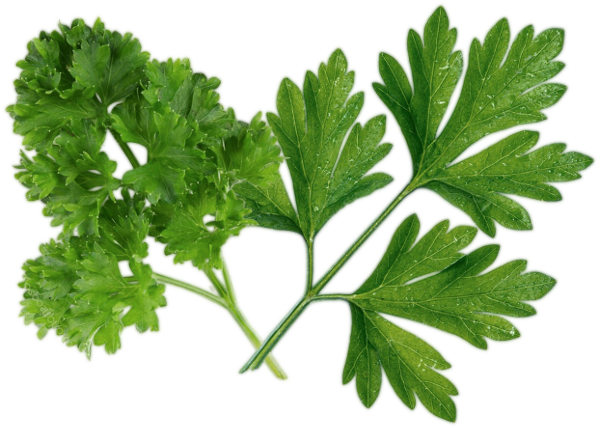
Petroselinum Crispum: From the Apiaceae family, part of the Apiales (umbellifer) order. Parsley leaf is an herb used as a flavoring in food and condiments, as well as a popular garnish. Parsley root - particularly the Hamburg root parsley - is a vegetable that looks very similar to a parsnip, but cooks faster and has a sweeter taste described as a cross between celery, carrot, and parsnip. Parsley leaves, seeds and root are sometimes used in medicines, and the seed oil is used as a cosmetic fragrance. Parsley may have been cultivated in Sardinia around the 3rd century BC, and there is literary evidence to suggest that parsley was used in England as early as 660–1066AD during the Anglo-Saxon period.
"PARSLEY" is a combination of 'petersilie' from Old English or contemporary German, and 'peresil' from Old French; both derived from the Medieval 'petrosilium' and Latin 'petroselinum;' as well as the Greek 'petroselinon,' which means 'rock-celery' - a combination of 'petra,' or 'rock' or 'stone,' and 'selinon' or 'celery.'
There are two main types of herb parsley commonly available. Italian or flat leaf, and French or curly leaf.

Italian:
- Flat leaves are sometimes mistaken for cilantro
- Stronger in flavor, said to be more robust

French:
- Curly leaves are more decorative for garnish
- Milder in flavor, suitable for cream sauces
Parsley is a good source of dietary fiber containing vitamin K, which helps blood to clot and contributes to bone health. Parsley is also rich in vitamin A and potassium, with vitamin C, calcium, folate or folic acid, phosphorous and other antioxidants - helping to reduce the risk of diabetes, stroke, heart disease and cancer. Parsley is considered a bitter herb, stimulating the release of bile and producing glutathione for liver health, and parsley is also used to cure anemia thanks to its high iron levels.
Fresh parsley leaves have an earthy flavor with a clean, peppery taste. Dried parsley is largely thought to be flavorless but is mainly used to add color and earthiness to a dish. The stems are edible as well, although they're stronger and more bitter in flavor. I suggest using the stems finely minced in Tabbbouleh or in cooked applications like sauces, stews and stocks.
NOTE: Your parsley will last longer in the refrigerator if you place a slightly damp paper towel with the parsley in the grocery vegetable bag, and inside your crisper drawer. This trick works with most green leaf herbs and vegetables.
{ FRIED RAVIOLI }
I was hanging out at my friend's house and we were getting hungry. Not wanting to go out to eat, we decided to eat something that they had in the kitchen. Unfortunately not all of my friends keep a well-stocked kitchen like I do, and this particular friend liked to eat a lot of junk food. I'm known to enjoy quite a bit of junk food - but they mostly buy heat-and-eat stuff, and some of that is pretty low in nutritional value and terrible tasting.

Normally, I don't buy frozen ravioli. I don't really buy fresh stuff, either. I usually make a baked pasta dish or pull out my ravioli press - but, to each their own. There's a certain kind of spinach ravioli that I'm particularly not fond of, but for sitting around and watching movies, this was going to be perfect.
Toasted Ravioli: Made popular in the early 1940's, with origins tracing back to Sicily from St. Louis, Missouri, deep-fried ravioli begins with an ambiguous story about a ravioli accidentally being dropped into a deep fryer at an Italian restaurant during some sort of drunken commotion. Don't forget about the meatball rolling off of the spaghetti and onto the floor also. Somewhere along the way the name was changed to 'toasted' ravioli instead of 'fried' because it souded 'cooler,' and also shortened to 'T-Ravs.'

Okay, well Toasted Ravioli are now traditionally breaded before they are fried and I prefer to fry my ravioli 'naked.' These raviolis were fairly thin and pre-cooked so I was able to fry them from frozen, but if the ravioli is thicker or contains raw meat you probably want to thaw them first. You can use refrigerated raviolis as well or tortellini if you prefer, the frying process is very straightforward here.
NOTE: The important thing to remember when you fry these puppies is that - if the raviolis are frozen - they will cause a small eruption when you drop them into super-hot oil, so make sure your fry oil is just below temperature (around 300–325°), and either drop them away from you one or two at a time or lower them into the oil with a slotted metal spoon.
We didn't have a deep fryer, so I used a large chicken fryer pan and worked in batches with a pair of tongs. It only took about 20-30 minutes to do the whole bag. After your raviolis are fried to a nice golden brown and crispy on the outside, just sprinkle them with parmesan, fresh parsley if you have it, and serve with warm marinara for dipping. This snack food is a crowd-pleaser and couldn't be easier.
July, 2018 CAULIFLOWER KIMCHI FRIED RICE
KIMCHI: A spicy Korean side dish traditionally made with napa cabbage and gochugaru (Korean chili flake). The salty, fermented mixture is sharply acidic, reminiscent of a spicy Korean sauerkraut, also containing garlic, ginger, scallions, fish sauce, and rice flour.
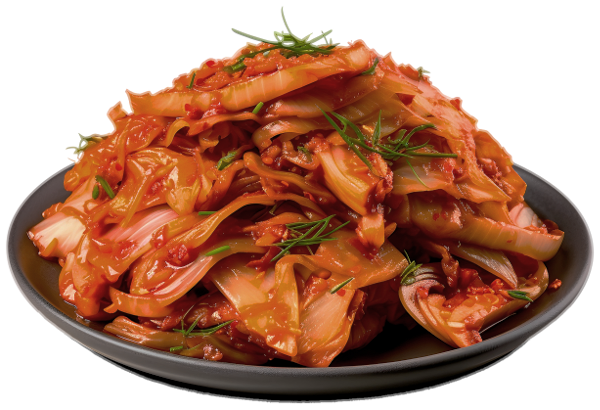
*It's easy to make kimchi at home! I prefer the recipes that start with fresh squid - you can find a few authentic recipes for kimchi on Maangchi.
I don't use kimchi very often, and certainly not enough to justify posting a recipe for it. However, if you need some kimchi and don't want to buy an entire bottle of it, you can make something very similar relatively quickly.
Mock Kimchi: Take a small portion of napa caggabe and simply rub it with salt and a pinch of sugar. You may also want to add some sliced scallion or green onion. Let that soften for about an hour to an hour ½ at room temperature, rinse the cabbage, mix it with a tablespoon or so of Gochujang and a splash of fish sauce until it is thouroughly covered and store it in your refrigerator for at least 2-3 hours, or overnight for the best results. If it's not spicy enough, add some Sriracha.
I had some leftover kimchi from a Korean restaurant and I wanted to use it up. As Plato said, "Necessity is the mother of invention." Continuing with the cauliflower theme from my last post, I am pleased to say that this recipe was so good I plan to make it every time I have kimchi on hand.

FC CAULIFLOWER KIMCHI FRIED RICE:
| White Rice | : | 1 cup, cooked &
cooled to room temp. |
|---|
| Cauliflower | : | ½-1 cup, small florets |
|---|
| Kimchi | : | ¼ cup, smaller pieces |
|---|
| Carrot | : | ¼ cup,
⅜-½" rustic cut |
|---|
| Safflower Oil | : | 2-3 tbsp, divided |
|---|
| Soy Sauce | : | 1-2 tsp, to taste |
|---|
NOTE: Fried rice is usually made with yesterday's cold rice. If you are using freshly cooked rice, spread it out on some parchment paper and let it dry out for at least 30 minutes to an hour before frying it.
DIRECTIONS:
Wok or Skillet- Heat half of the oil until it is HOT. Add cauliflower and carrot.
Stir-Fry- shake and flip for about 2-3 minutes or until just softened.
Add- the rest of your oil, room temperature rice and soy sauce, continuing to heat on high 2-5 minutes.
Stir Constantly- until vegetables are al dente or fork tender and rice is heated through.
Fold-In- kimchi, turn off the heat, and allow to rest in the residual heat of the pan, stirring gently until kimchi is warmed through.
June, 2018 PERFECTION IN BROILING - Cauliflower

Brassica Oleracea: From the Brassiceae family, part of the Brassicales (mustard) order. The head of a cauliflower - scientifically referred to as an inflorescence meristem - may be cut into edible portions, or florets that are sometimes called 'curd' based on their resemblance to cheese curds.
"CAULIFLOWER" is derived from the Italian word cavolfiore, or "cabbage flower;" a combination of 'caulis' and 'flōs,' the Latin words for 'cabbage' and 'flower' respectively.
FC CAULIFLOWER:
| Cauliflower | : | 1 large head, or
2-3 cups of florets |
|---|
| Onion | : | 1 small, sliced thin |
|---|
| Parmesan | : | 2-3 tbsp, to taste |
|---|
| Olive Oil | : | 2-3 tbsp |
|---|
| Choice Salt | : | 2-3 pinches, to taste |
|---|
| Thyme | : | 1 pinch, to taste |
|---|
DIRECTIONS:
Baking Sheet- Preheat the broiler and toss cauliflower with all ingredients except parmesan cheese, spreading out evenly on baking sheet.
Broil- on the middle or lower rack for 12-15 minutes or until slightly browned and al dente.
Remove- cauliflower from oven and sprinkle with parmesan.
Broil- on the middle or top rack for 1-3 minutes or until cheese is melted and bubbly. NOTE: Cooking times will always vary based on ovens and types of pans. Feel free to omit the cheese or some of the oil for a lower fat version, but be careful - the cauliflower might burn without lube!
May, 2018 SAFFLOWER + SAFFLOWER OIL

Carthamus Titorium:From the Asteraceae family, part of the Asterales (asterid) order. Safflower is one of mankind's oldest known crops, first cultivated in Mesopotamia as early as 2500 BC. The thistle-like plant was used by Spanish colonies along the Rio Grande, and is commercially cultivated for its seed oil. The petals, ranging from deep red to yellow when dried, have been used for centuries as Carthamin pigment dye, giving textiles and cosmetics anywhere from a deep orange-red or rich golden-orange, to a pale yellow hue. In cooking, safflower petals are mostly used for herbal teas, natural food coloring, or as a substitute for saffron. While they both have a vibrant orange color, safflower much more affordable and has a noticably milder flavor. If you are planning to replace the saffron in your recipe with safflower, it is suggested that you use at least twice the amount.
"SAFFLOWER" is from the Middle French 'safleur,' from the Arabic 'aşfar' or 'yellow;' the Dutch 'saffloer' and the German 'Saflor,' a combination of 'safran' or 'saffron,' and 'fleur' or 'flower.' Safflower is sometimes referred to as "Bastard Saffron."

Safflower Oil is rich in linoleic acid, one of the essential fatty acids that may help reduce heart disease - possibly preventing blood clots, widening blood vessels, and lowering blood pressure - although this lacks scientific study. Safflower oil is also camparatively low in saturated fat, and is unofficially recommended for people with high cholesterol. For people with diebetes, refined safflower oil can allegedly lower blood sugar if used to replace saturated fats or carbohydrates. High in omega-6 fatty acids, safflower oil could possibly cause inflammation unless balanced with omega-3 fatty acids, which are found in foods like walnuts, brussels sprouts, and cod.
Safflower oil is relatively flavorless, making it a good choice for stir-frys, deep-frying, and baked goods. The oil remains liquid in the refrigerator, so you can also use it to make salad dressings. There are three diffferent versions of safflower oil to choose from:
High-Oleic:
- High smoke point - 440° to 520°F
- Contains more monounsaturated fats
- Suitable for high-heat cooking
Regular Refined:
- Middle smoke point - 320°F
- Best for medium-heat applications.
Unrefined:
- Low smoke point - 225°F
- High in the antioxidant vitamin E.
- Only for low-heat applications
A fun thing to do with safflower oil is infuse it with more safflower and a bit of saffron.
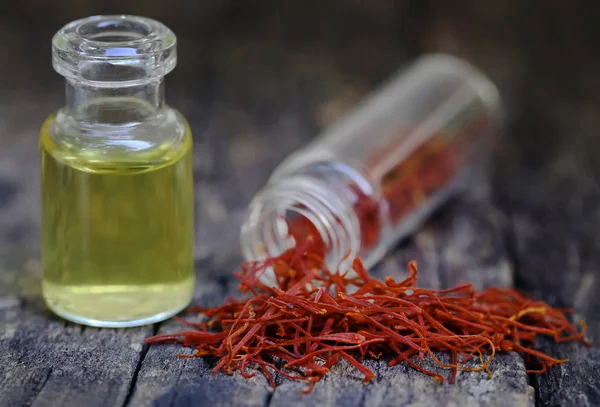
FC INFUSED OIL:
| Safflower Oil | : | 1 ½ part |
|---|
| Safflower | : | 1 part |
|---|
| Saffron | : | 1 sizeable pinch + extra |
|---|
DIRECTIONS:
Lidded Glas Jar- fill with safflower and saffron, making sure there is 1–3 inches of open space.
Fill- jar with oil, covering spices by at least one inch. Cap the jar tightly and shake well.
Place- jar on a warm, sunny windowsill and shake at least once per day for 2–3 weeks.
Cheesecloth or Mesh Strainer- after 2–3 weeks, strain the oil, making sure to squeeze the oil out of the spices.
Funnel- oil into a glass bottle. Add another small pinch of saffron, shake and store in a cool, dark place. NOTE: You may want to use a heat-infusion method instead. Gently heat the oil and spices between 100° and 140° for 1–5 hours, or until desired flavor and color is achieved. Allow to cool before straining and decantering.
April, 2018 SELF-RISING FLOUR

1845:Henry Jones (1812–1891) invented self-rising flour as a baker in Bristol, England.
This pre-mixed combination of flour and baking powder comes in handy whenever you want to make scones, biscuits, or other baked goods on the fly - I've even used it to make deliciously moist muffins in the toaster oven! Just measure it out, sift it together and keep it in your pantry for convenience. No more remembering exact amounts for quick baking!
| ALL PURPOSE FLOUR | : | 1 Cup |
|---|
| BAKING POWDER | : | 1 ½ tsp |
|---|
*Don't Add Salt Until You Need It!
Traditionally you would add anywhere from ¼ to ½ teaspoon of salt per cup of self-rising flour, but when I make my favorite chicken nuggets I never add salt until after they're fried. It's up to you! Also, if you are baking sweets and want to use salted butter instead of unsalted, go ahead - no extra sodium necessary!
| Baking Powder = | 1 Part Baking Soda
2 Parts Cream of Tartar |
|---|
Given this general ratio, although it will probably change the texture of your recipe a teense, you could substitute ½–1 tsp of Baking Powder for every ¼ tsp of baking soda if needed.
March, 2018 TIPS TO REMEMBER - Meat Safety
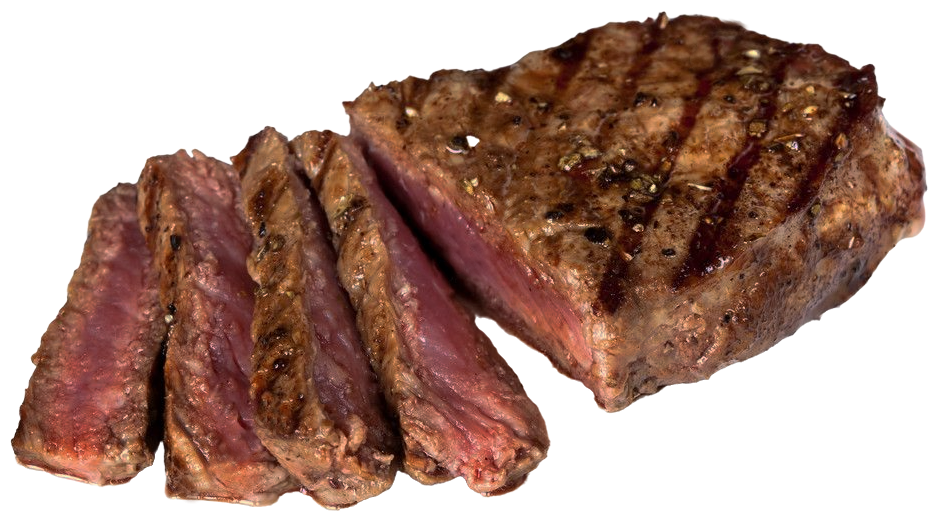
“Winning is not a sometime thing, it's an all-time thing. Don't do things right once in a while .. do them right all the time .. The quality of a person's life is in direct proportion to their Commitment to Excellence, regardless of their chosen field of endeavor.” - @VinceLombardi
MEAT HEATING CHART:
115° | : Beef, Rare
Salmon, Rare | | 120° | : Beef, Medium-Rare
Salmon, Medium-Rare |
|---|
130° | : Beef, Medium
| | 135° | : Salmon, Medium
|
|---|
140° | : Beef, Medium-Well
Pre-Cooked Ham | | 145° | : Most Steaks
Pork Chops
Veal
Bison
Lamb
Goat |
|---|
160° | : Beef, Well Done
Ground Meat
Rabbit
Venison | | 165° | : Pork Roast
Whole Poultry
Poultry Stuffing
Sausages
Giblets |
|---|
February, 2018 TIPS TO REMEMBER - Oleos
 It's easy to get both the flavor of butter with the health benefits of coconut oil using this simple substitution formula:
X = ½ butter + ½ ( ⅔ ) coconut oil
EXAMPLE:
If the recipe calls for 1 stick of butter, use only ½ that, or ¼ cup butter. For the remaining ¼ cup or 12 tsp, substitute 8 tsp coconut oil. If it's tough to calculate use less rather than more.
Make your own blend of butter and coconut oil ahead of time for easy use. Melt it together and then mold it in the refrigerator. I use 2 parts coconut oil + 1 part butter. So ono!
Low Fat usually means higher in sugar & salt [fructose/carbohydrates and sodium].
Brown some butter ahead of time and keep it handy in the fridge.
Make a roux and keep it in the freezer for quick soups and gravies.
Save oils like tallow and bacon fat in the freezer or fridge for cooking with.
When sautéing or grilling, add a splash of alcohol for depth of flavor, but be careful! The higher the proof the more flammable it is, so use a shot glass or small measuring cup - never pour straight from the bottle!
January, 2018 HANDY MEASURE EQUIVALENTS
Convert cups with ease…
{ CATERING CONVERSIONS }
These are a bit archaic, you probably either know these already or never use them.
| 1 Pint = | 2 Cups |
|---|
| 1 Quart = | 2 Pints or 4 Cups |
|---|
| 1 Gallon = | 4 Quarts, 8 Pints, or 16 Cups |
|---|
| 1 Peck = | 2 Gallons, 8 Quarts, 16 Pints, or 36 Cups |
|---|
| 1 Bushel = | 4 Pecks, 8 Gallons, 36 Quarts, 72 Pints or 144 Cups |
|---|
|




































 Restaurants
Restaurants